Antardwipa Prabhu, his wife, Klara, and Goura Karuna Prabhu did harinamawith me in Prague for two hours the final day, which was a sacrifice as we were tired from late nights at the music festival.
We followed the usual Prague harinama route through the tourist areas, including Old Town Square, where our Ratha-yatra is held.
Gaura Karuna Prabhu distributed books.
It rained, and we chanted under a covered section of a famous bridge. One guy danced with us.
Tour groups were stuck there listening to us because of the rain.
Between tunes I said a few words to them about the effect of the mantra. It was a memorable experience. My bus to Berlin was late, but I did not care as there is free wireless internet at Prague’s Florenc bus station.
I thank Klara, Antardwipa’s wife, who kindly took the pictures, as well as chanting the response, and once leading an attractive tune.
Berlin Harinama
I spent a day in Berlin, staying at the flat where Lord Jagannatha and His pujari, Hrdaya Gauranga Prabhu (on the left in the below picture) live, quite near the site of the old temple.
Hrdaya Gauranga Prabhu was happy to have another person to do the first half of the morning program with, and we were happy that Siddha Svarupa Prabhu joined us for the second half. In the class, I talked about Lord Balarama as it was His appearance day the next day, and I would miss it, because in England they observed it today. I told about how Balarama often plays the role of a mediator, and gave some examples such as when Duryodhana and Bhima were fighting and when the Kurus arrested Samba and the Yadus were upset. I also read Lord Balarama’s instructions on spiritual life which He gave to Queen Rukmini, His sister-in-law, on her wedding day.
The three of us went on harinama in the afternoon. After forty-five minutes, Paramatma Prabhu, along with a devotee boy, came and distributed books nearby for an hour or so, and then joined us for the end of the kirtana. When we had all five devotees chanting it was very dynamic. The little boy danced, jumping up and down, and attracting attention.
I was happy dancing and distributing invitations as usual.
One young photographer named Tobi who I later found was familiar with the devotees, stayed with us for an hour or so, taking pictures of us from time to time, especially when the kirtanabecame wild or when people interacted with us. I gave him my card, and asked him to send me the pictures which he did. Although the harinamawas a little slow in the beginning, it became a wonderful experience in the end.
Sunderland Harinama
Sunderland is one of the bigger cities around Newcastle, and we have developed a program of going there once a week and doing harinama, followed by prasadam and kirtana at Ramai and Vrinda Prabhus place there.
Satya Medha Gauranga Prabhu, who works in Sunderland and who distributed books and chanted there as a brahmacari, took his lunch hour when we were chanting there so he could join us. Thus we were wearing dhotis, casual dress, and formal dress, altogether on harinama.
Some boys came and played the tambourines and the gong with such intensity that a shop owner complained, and we learned that you cannot allow kids to play the gong or it will be way to loud
York Harinama and Program
We had our Janmastami program in York the Saturday before, and had about seven people for the harinama in York beforehand. Govardhan Dasi sings in public there every Saturday for two hours along with her husband, who distributes invitations, and she was happy to have many more devotees.
The nama-hatta program for Janmastami had variety, including kirtana, two dramas, and a song about Krishna’s pastimes. I also gave the first of four lectures on Krishna’s appearance, the others being in Leeds, Newcastle, and Liverpool. Twenty-four people came although the program has not been going more than a few months. Govardhan Dasi did a great job organizing it, and Ganesh Prabhu, Dennis, and others helped greatly.
Leeds Harinama
Caru Candra Prabhu was there for almost the entire three-hour harinama, and a couple ladies came near the end so we had three people for the last hour and four people for the last twenty minutes. The last twenty minutes we walked to the car, exposing people along the way to the chanting.
Chester-le-Street Harinama
Ananta Nitai Prabhu, Prema Sankirtana Prabhu, Malvika, Atul, and I went on harinama in Chester-le-Street. I think the residents there must have decided that they liked us when we came last time because the people were so favorable. A friendly older lady praised our singing, gave us a pound, and said she had heard us in Newcastle too. As we often do now, we brought tambourines for interested kids to play. First a girl played.
Then a boy and girl happily played, and the mom was happy to watch them and gave a donation.
People gave £22.63 ($35.28) in three hours, making probably it the most charitable place we have been in the Newcastle area, and we distributed about seven books.
Newcastle Harinamas
One day in Newcastle many people danced with us and/or played the instruments. It started out with a small girl who played tambourine for 10 or 15 minutes on two different occasions.
Her friend was not interested, but patiently waited on her bicycle, for her to finish. The girl played in time and seemed to have some taste for it.
Then one young lady came who was visiting from Leeds but had lived in Arab countries for many years. She loved to dance and play the tambourine, and stayed for an hour or so.
Then a boy danced.
And then a man.
Then a very energetic young lady.
It was inspiring to see the enthusiasm for participation in Lord Caitanya’s merciful sankirtana process.
During our Janmastami harinamain Newcastle, a jovial man gave us a pound, and accepted a Path of Perfection.Then he told a story: In the 1980s, when in his 20s, he was in Gainesville, Florida, and lost his passport, his green card, and his money. But the Hare Krishnas gave him something to eat, and he said he would never forget it! Krishna Lunch Gainesville ki, jaya!
Harinama on Vyasa Puja was a challenge for me. I am not used to living in temples where the Vyasa Puja feast is served at 5 p.m. so we had no choice but to try to do harinama from 6:00 to 9:00 p.m. Ananta Nitai Prabhu and I were ready to leave at 6:30 p.m., but we lost a lot of time waiting for people to take prasadam and then trying to convince them to come with us. We were unsuccessful in our attempts as many devotees either had still to complete their daily chanting on beads or needed to help with the cleanup, so we chanted by ourselves from 7:45 p.m. to 9:45 p.m.! Most of the shops close at 8:00 p.m., but we chanted across from a McDonalds that is open 24 hours a day. A lot of young people were hanging out with their friends outside the McDonalds. Several people danced with us for awhile, especially the girls and those of African descent. One drunk middle-aged man spoke favorably about us and played the tambourine with us for about five minutes. A couple girls danced for a couple minutes. I am sure because of going out at a time when we never go out, we encountered people who had not seen the devotees before nor heard the kirtana, and that was Srila Prabhupada’s mercy on his auspicious appearance day.
Since I was leaving the next day for Manchester and would not return till next spring, when Ayan began to drive us downtown for harinama, the devotees chanted Hare Krishna as a going away blessing.
Prema Sankirtana Prabhu even blocked the car.

In general, harinama in Newcastle went nicely for me this year. Prema Sankirtana Prabhu, who is full of enthusiasm, and great at getting people to interact with our party, especially by dancing and also by playing the tambourines, would often come out. Malvika, who has a beautiful voice and lots of enthusiasm, would almost always come out. Bhakta Rasa Prabhu, who has been doing outreach in Newcastle for over twenty years, would try to come out once a week. Ananta Nitai Prabhu, who I had done many, many harinamas in Ireland, kindly came to Newcastle for two weeks and went out almost every day. Satya Medha Gauranga Prabhu is almost always willing to chant in Sunderland during his lunch break, and on Saturday in Newcastle. Also last, but not least, Vrinda and Vishnu Priya periodically invite the harinama parties over to their places for lunch or dinner to serve and to inspire the devotees, which we are always grateful for. Thus Krishna inspired me by giving me a good group of people to chant with there in Newcastle, and I look forward to returning next year and doing harinama with my friends.
A Double Harinama Day
The coach from Newcastle to Liverpool was too expensive so I booked one to Manchester and found an advance purchase ticket on the train from there to Liverpool for £4. I thought of leaving my bags and getting some prasadam at the Manchester temple, but later decided to do harinama for an hour and a half or so with my friend, Gaura Das Prabhu, who does book distribution in Manchester on Fridays. Then in Liverpool before the monthly nama-hatta, I chanted for two and a half hours there. Several people gave donations, most not taking books. A Polish lady who regularly attends the nama-hatta program happened by and bought an Isopanisad and a music CD giving £5. At one point I was so tired from staying up late on Janmastami and Vyasa Puja, I was falling asleep, and I prayed to Lord Caitanya to keep me awake so I could sing. It worked, and I was thus able to continue.
Unexpected Manchester Harinama
Usually the last Saturday of the month we chant in Bolton, but everyone was wiped out from Janmastami and Vyasa Puja or else had other engagements so there were just three of us. Since two of us lived in Manchester, we convinced Vrajendralal Prabhu, our leader from Bolton, to come into Manchester and chant with us there. He brought another devotee, and ultimately more came, and we had eight or nine devotees singing for almost two hours in Manchester on a very beautiful day in a city filled with many people.
Our leader said we passed out more invitations than ever before, although we gave them only to people who showed some signs of interest. A couple of Muslim girls Jagatatma Prabhu gave cards to, chanted the mantra and followed us for a few minutes, a rarity. A few people danced with us, like the ones below.
People at outside cafes showed their appreciation.
I felt that I was instrumental in saving the harinama, which could have easily been canceled due to too few participants.
Insights
Srila Prabhupada:
from Sri Caitanya-caritamrita, Madhya 7.148, purport:
“Although Vasudeva Vipra was a leper and had suffered greatly, still, after Sri Caitanya Mahaprabhu cured him He instructed him to preach Krishna consciousness. Indeed, the only return the Lord wanted was that Väsudeva preach the instructions of Krishna and liberate all human beings. That is the process of the International Society for Krishna Consciousness. Each and every member of this Society was rescued from a very abominable condition, but now they are engaged in preaching the cult of Krishna consciousness. They are not only cured of the disease called materialism but are also living a very happy life. Everyone accepts them as great devotees of Krishna, and their qualities are manifest in their very faces. If one wants to be recognized as a devotee by Krishna, he should take to preaching work, following the advice of Sri Caitanya Mahaprabhu. Then one will undoubtedly attain the lotus feet of Sri Krishna Caitanya, Lord Krishna Himself, without delay.”
from Sri Caitanya-caritamrita, Madhya 8.38, purport:
So-called followers of Vedic principles simply accept the Vedas formally, but they act against Vedic principles. This is symptomatic of this Age of Kali. People claim to follow a certain type of religion, saying formally, “I am Hindu,” “I am Muslim,” “I am Christian,” “I am this or that,” but actually no one follows the principles enunciated in religious scriptures. This is the disease of this age. Therefore the merciful Sri Caitanya Mahaprabhu has simply advised us to chant the Hare Krishna maha-mantra:
harer nama harer nama harer namaiva kevalam [Cc. Adi 17.21].
The Lord can deliver anyone and everyone, even though one may have
fallen from the injunctions of revealed scriptures. This is Sri Caitanya
Mahäprabhu’s special mercy. Consequently He is known as patitapavana,
the deliverer of all fallen souls.
from Sri Caitanya-caritamrita, Madhya 8.83, purport:
Actually one can take shelter of such spiritual mellows only when one is completely uncontaminated by material attachment. When one is completely free from material attachment, the feelings of the transcendental mellows are awakened in the heart of the devotee. That is svarupa-siddhi, the perfection of one’s eternal relationship with the Supreme Lord. Svarupa-siddhi, the eternal relationship with the Supreme Lord, may be situated in any one of the transcendental mellows.
from The Nectar of Instruction, verse 3, purport:
One should not be impatient in Krishna consciousness. Indeed, this Krishna consciousness movement was started single-handedly, and in the beginning there was no response, but because we continued to execute our devotional activities with patience, people gradually began to understand the importance of this movement, and now they are eagerly participating. One should not be impatient in discharging devotional service, but should take instructions from the spiritual master and execute them with patience, depending on the mercy of guru and Krishna.
from The Nectar of Instruction, verse 4, purport:
“. . . by chanting the holy names of the Lord we can actually convert many people throughout the world to Krishna consciousness. Contributing or distributing the holy name of the Lord is a sublime example of contributing or giving charity (the dadati principle).”
Satsvarupa Dasa Goswami:
from his journal, Viraha Bhavan, “Poem for August 16”:
“The Divine Couple
are intoxicated by
Their love for
one another, and their pure devotees
share that happiness through service.”
from Japa Reform Notebook:
"Regarding your question, there is no such requirement that japa should be silently and chanting should be done differently. Loudly or silently, everything is all right. There is no such restriction. Only thing is that we should chant very attentively, hearing the vibration very distinctly."
—Letter from Srila Prabhupada to Satsvarupa March 8, 1969
Guru Das Prabhu:
from talks at Trutnov, the Czech Woodstock:
We chant in the spirit of not expecting some result. We chant with a desire to serve Krishna.
Srila Prabhupada wrote eighty books answering the questions, “Who am I?”
“Where am I doing?” and “What am I doing?” While we were sleeping, he was writing.
Those of you who have chanted are taking part in the process. You are interacting not just believing or listening.
We have an individual relationship with Krishna. We want to think of Krishna day and night. When we sing Hare Krishna, Krishna is dancing on our tongue, and Krishna enters our heart, along with the cowherd boys and girls and the peacocks, in His beautiful form.
There are so many things to do and see here, but somehow Krishna has entered your heart, and you have come hear. It is very peaceful here.
When Krishna’s love develops in our heart, we love others.
This is a world of duality, but in Krishna consciousness, we can harmonize the duality. We can become transcendental.
There is no coming down once you experience this. You do not have to look around the corner for some substance.
In the 1960s, some of the leaders understood there is more to music festivals than getting together, hearing music, and getting high. It is to make progress on a spiritual search.
John Lennon and George Harrison chanted Hare Krishna for three days enroute to Morocco.
There is a regulative stage and then a spontaneous stage where life becomes an adventure that will even blow your own mind.
In the 1960s, we were searching for wisdom, American Indian, Buddhist, etc., and when we found it, we would live it. In San Francisco, they would wear their search.
In San Francisco, we put flowers in the policemen’s guns.
The Diggers, who were next to our temple, had free cloths, and they had a coat soaked in LSD, and people who knew would cut pieces off of it and trip all day.
The Be-ins were a place you could be yourself. Everything was free.
Srila Prabhupada taught there is a way to be high from what you have inside. There is a way to be high from plain living and high thinking.
I met the leaders of the counterculture but none were so personally compassionate to me as Srila Prabhupada.
In London, every day we would send something to the Beatles, the story of Prahlada Maharaja, a wind-up apple with Hare Krishna written on it, an apple pie with Hare Krishna written on it. Nothing worked. The Hells Angels planned to break up the Beatles’ office. Then George saw us, and said that he was so glad to finally meet us. We had a friendly relationship with the Hells Angels, and so they decided to desist from causing disturbance when they saw the Beatles were friendly to us.
George was funny. He liked one Monty Python joke. Two people are talking. One says, “We were so poor we slept on the floor.” The other replies, “You had a floor?”
Once George played the Govinda song on a ukulele and it sounded like an orchestra.
The song “Something in the Way She Moves Me” by George Harrison was actually written referring to Krishna, but George thought if he said “Something in the Way He Moves Me” people would have thought he was homosexual. Frank Sinatra says that song was the best love song ever written.
Here the people are willing to make the choice to change. Krishna has guided you here. Thank you for choosing to come here.
Love is Krishna. You always see Krishna with cows, peacocks, trees, etc.
There are two types of love: love where you expect something and love where you do not expect something.
Srila Prabhupada came to share that pure love in his old age, suffering two heart attacks crossing the sea, but he was not discouraged.
I was schooled in the 1960s. We did not just accept what we heard. We wanted to experience it.
It is more effective if you chant in addition to hearing. It is a question of your heart reaching out to God.
How would you like to stay high forever?
When you do not identify yourself with your body, you can connect with everyone in the world.
You are hearing. Many act. Now you can be part of the act. We are not an act. When we were recording with the Beatles, we had to tell the people we are not just an act. We are monks. This is your chance to be a monk for a day.
Jagatatma Prabhu:
The materialists ask God for a way to make their life of hard work for illusory goals comfortable. The impersonalists want to stop the illusory work altogether because they do not know about the sweetness of working for the pleasure of the Lord.
Vaidhi bhaktiis forced, but you have to apply the force. This is voluntary.
The mode of ignorance is compared to wet fuel, the mode of passion is compared to damp fuel, the mode of goodness is compared to dry fuel.
We can help people who want to serve Krishna, but until the people decide themselves that that they really want to serve Krishna, we cannot help them.
I can help you start a fire, but if you are pouring water on it, what can I do?
One of the acaryas describes that Anukula is a name for Radharani and thus anukulyena means to become a servant of Radharani.
As devotees of Krishna, we do not want to go to Vaikunthaloka if Krishna is not there. And as followers of Lord Caitanya we do not want to go unless both Krishna and Radharani are there.
Lord Caitanya is giving us this information that Krishna is not attracted opulent worship but by intimacy. That gives him the most pleasure, and if we are interested in giving Krishna the most pleasure, we must aspire for it.
Krishna was amazed by the love of Radharani and wanting to experience it, He came as Lord Caitanya, and as Lord Caitanya after experiencing that, he wanted to experience the greater ecstasy of serving the gopis in their service of Radha and Krishna. This is described in the Caitanya-caritamrita when Lord Caitanya went into trance and experienced collecting flowers for Radha-Krishna under the direction of the gopis.
In the pastimes of Lord Caitanya, the devotees are always feeling separation from Krishna, and in the pastimes of Krishna, they are experiencing union with Krishna. Because the love in separation is more intense, Lord Caitanya is giving His associates even more love than before. Thus it is called audarya-lila because Lord Caitanya is giving more mercy.
To attain perfection we have to identify with our spiritual situation as a servant of the intimate servants of the Lord and not our situation as a resident of Manchester or wherever.
Acarya Prabhakar, Srila Prabhupada’s first disciple, told an amazing story of Srila Prabhupada at the temple in Chipawada. He heard Srila Prabhupada playing the mrdanga and loudly singing. He came up to Srila Prabhupada’s room, and saw he was wearing a garland of kadamba flowers down to his feet, and they were about four times bigger kadamba flowers than you find around Delhi and had a wonderful fragrance filling the room. And in addition to playing the drum and singing, he was dancing around the room like a madman. Acarya Prabhakar had to wait a while for him to settle down. Srila Prabhupada explained that Krishna had appeared, and had said Prabhupada would be successful in his preaching mission in the West, and that He would personally help him. Then Krishna took His garland and put it around Srila Prabhupada’s neck and disappeared.
Hanuman’s eternal position is servant of Lord Rama and Laksmi is the eternal consort of Lord Narayana. This cannot be changed. It is not that they should aspire to be maidservants of Radha Krishna.
It is described that Lord Narayana is all-pervading yet He does not enter Vrindavan or Dvaraka.
The original Krishna does not kill demons, His aspect as Vasudeva does that work and disappears when it is done.
Lord Caitanya gives even the eternal associates of Krishna something more. Ramananda Raya knew Radha Krishna but Gaura revealed that His form Gaura was a combination of both, which was a new experience for him.
Rasa and prema are not static but can be changed.
Ananta Nitai Prabhu:
If you were in complete control, you would never have an accident. There must be a controller beyond you.
The laws of physics are acting everywhere. It is not that there is just chaos.
Notes on Vyasa Puja Offerings in Newcastle
Krishna-kripa das:
On Vyasa Puja we worship the guru as the representative of Srila Vyasadeva, the compiler of the Vedic literature. It is hard to imagine a greater representative of Srila Vyasadeva than Srila Prabhupada, who translated Vyasa’s ultimate literature, Srimad-Bhagavatam, into English, with relevant commentaries for men of the present age, and who engaged his disciples in translating it to all the important languages of the world, and distributing it to the people in general.
We usually celebrate with offering of flowers (puspanjali), an arati, a feast, and homages.
I am inspired by Srila Prabhupada’s presenting Krishna consciousness as a clear spiritual science without the vagueness often there in other presentations of spiritual ideas.
From my traveling I appreciate how Srila Prabhupada has inspired people in devotion to Krishna all over the world.
I think any of us who have appreciated anything Srila Prabhupada has given should offer some words of appreciation on this day, and to facilitate this I will shut up to allow others time to speak.
Bhakti Rasa Prabhu:
Srila Prabhupada lived at 151 Harrison (Hari’s son) Road in Calcutta in his youth, and many Harrisons, most notably George, have since developed an interest in Krishna.
I was confused about who to accept as a spiritual master, so I prayed to you, Srila Prabhupada, at a guru-pujain Mayapur, “You know your disciples and you know me, please select the person who would be the best guru for me.” Then I came out of the temple, and a devotee was selling his guru’s books right in front of me. His guru was Satsvarupa Dasa Goswami, and I spent my whole brahmacari allowance on his books. By reading them I decided upon Satsvarupa Dasa Goswami as my guru, and I consider that was your direction, Srila Prabhupada.
Ananta Nitai Prabhu:
I had a dream in which Srila Prabhupada, at the top of some stairs, said to turn down the music and to distribute his books, and then at the end I embraced him as a child does his parents, as he came down the stairs. I was very much into mundane music before meeting the devotees and took it that Prabhupada was telling me to give that up. I was already distributing his books, but that sealed my commitment to Srila Prabhupada to keep doing that service.
The first day on the street I collected 34 pence. The next day was not much better, but I persevered, and things improved, and I ultimately found my niche, selling books door to door.
Tribhuvanatha Prabhu inspired me by telling me, “Your service is your lifeline to Krishna.”
If anyone seriously reads Srila Prabhupada’s books, he cannot ignore them.
We are all here because Srila Prabhupada came to give. He did not come to take.
Prema Sankirtana Prabhu:
I am so glad, Srila Prabhupada, that you invited us to be part of Lord Caitanya’s chanting and dancing party.
The bike shop lady who greets our chanting party when we pass her shop, came looking to buy our camper. She saw Jiya, my three-year old daughter, chanting on beads and asked Jiya what she was doing, and Jiya replied, “Japa.” “What’s in the bag?” the lady asked, and Jiya pulled out the beads, and Vishnu-priya, my wife, explained about chanting. The bike shop lady took a test drive of the vehicle, and then asked for five minutes to think about it. She decided to give the full asking price, but wanted one special favor, a set of japabeads. Harinama-sankirtana ki, jaya. Srila Prabhupada ki, jaya!
Ramai Prabhu:
Sometimes people ask me some spiritual doubt, and I remember something from your books, Srila Prabhupada, and I say that, and immediately they are satisfied.
Even your smallest book is fulfilled with unlimited spiritual truth.
That we were all celebrating Janmastami last night with such enthusiasm and happiness is an homage to you, for without you that would not be possible.
Ekacakranatha Prabhu:
Prabhupada, you are the greatest, and everything you are involved with is the greatest, such as the mission of Lord Caitanya and the chanting of the holy name, etc.
Whatever Krishna consciousness a person is able to take, he finds it benefits him.
Vrinda Mataji:
Everyone knows how great Srila Prabhupada is but I will tell one story from last night: One Indian couple came to our temple for the first time after visiting the local Hindu temple, where they had found not much happening on Janmastami. After awhile, they decided to see if anything had started to happen at the Hindu temple, but as they were leaving they asked some questions, like who the Panca-tattva was and why we had them and not Krishna on the altar. I explained about Lord Caitanya and His associates the best I could. Then they asked about the large murti of Srila Prabhupada, and when I told them the amazing story of Srila Prabhupada bringing Krishna consciousness to the West, they decided not to return to the Hindu temple, but stayed to midnight for the final kirtana and the feast after. Srila Prabhupada ki, jaya!
Ganesh Prabhu:
Thank you for allowing me to be an instrument in the development of our program in York, where we had a wonderful program for Janmastami last Saturday attended by 24 people, and during which I felt such ecstasy just by assisting in different ways.
Malvika:
Although I am from Asia, being born in India and living in Malaysia, I encountered Krishna consciousness in Newcastle (England) and thus I am also grateful to you, Srila Prabhupada, for bringing Krishna consciousness to the West.
I find reading books about Srila Prabhupada helps me in my appreciation of Srila Prabhupada’s books.
I began listening to Srila Prabhupada’s conversations while I was cooking, and I was feeling that I was in the room with the conversation.
Anna from Poland:
My mother heard Srila Prabhupada lecture in Poland during communist times, and she chanted Hare Krishna for many years but ultimately stopped. She did not tell me about her involvement with Hare Krishna until after I met the devotees myself. She said chanted when she was pregnant with me and that by the chanting I would calm down. Also when I was a baby, she said I would calm down and when she chanted. That explained why when I first encountered the Hare Krishnas in Poland that the mantra seemed very familiar to me.
One day I sat in the temple in front of Srila Prabhupada and prayed that if it was his desire that I go to India that I wanted to go, although I did not have the funds to go. Later my mom and my step-father told me they wanted to give me a present—a ticket to India. I am sure that was his mercy.
Bhakta Lauris:
I was amazed to hear there was this guy who came from India and spent twelve years in the West, and translated 60 books, and traveled around the world 14 times, and whose first disciples were hippies who were addicted to all kinds of intoxication. I did not see how it was possible, and I was attracted. Thank you for tricking us to become Krishna consciousness. May I always remain so tricked.
-----
naca, gao, bhakta-sange kara sankirtana
krishna-nama upadesi’ tara’ sarva-jana
“[Isvara Puri said to his disciple Sri Caitanya Mahaprabhu:] ‘My dear child, continue dancing, chanting and performing the congregational chanting of the holy name of the Lord] in association with devotees. Furthermore, go out and preach the value of chanting krishna-nama [the holy name of Krishna],for by this process You will be able to deliver all fallen souls.’” (Sri Caitanya-caritamrita, Adi 7.92)
 Indradyumna Swami: Yesterday we did harinama in Haifa, Israel's 3rd largest city. Israelis are celebrating their New Year and the beaches are crowded. As we experienced in Tel Aviv people spontaneously came forward to dance with us. I have never experienced this on such a scale in any other country of the world! Read more ›
Indradyumna Swami: Yesterday we did harinama in Haifa, Israel's 3rd largest city. Israelis are celebrating their New Year and the beaches are crowded. As we experienced in Tel Aviv people spontaneously came forward to dance with us. I have never experienced this on such a scale in any other country of the world! Read more ›  Indradyumna Swami: Yesterday we did harinama in Haifa, Israel's 3rd largest city. Israelis are celebrating their New Year and the beaches are crowded. As we experienced in Tel Aviv people spontaneously came forward to dance with us. I have never experienced this on such a scale in any other country of the world! Read more ›
Indradyumna Swami: Yesterday we did harinama in Haifa, Israel's 3rd largest city. Israelis are celebrating their New Year and the beaches are crowded. As we experienced in Tel Aviv people spontaneously came forward to dance with us. I have never experienced this on such a scale in any other country of the world! Read more ›  12 photos: Awesome flowery decorations for 20th August 2013-Jhulan Yatra Day in Iskcon Chowpatty Temple
12 photos: Awesome flowery decorations for 20th August 2013-Jhulan Yatra Day in Iskcon Chowpatty Temple  Will the future be a religious book, "competition" fiction and children's fairy tales? The issue date and controversial. God does not need advertisement. Still, a lot depends on how these priceless gifts are perceived by those who would like to still live by the laws of the spiritual world . After all, the holy book - not a dogma. And in order to present it to a secular society, it takes a special vision ...
Will the future be a religious book, "competition" fiction and children's fairy tales? The issue date and controversial. God does not need advertisement. Still, a lot depends on how these priceless gifts are perceived by those who would like to still live by the laws of the spiritual world . After all, the holy book - not a dogma. And in order to present it to a secular society, it takes a special vision ... 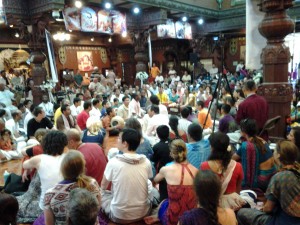


 54 photos: "London Saturday Night Harinam"
54 photos: "London Saturday Night Harinam" 
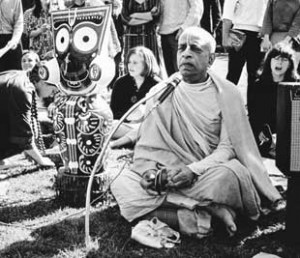
 Sri Siddha-Bakula is located near Gambhira Temple on Bali Sahi road in Sri Jagannatha Puri Dhama. Sri Caitanya Mahaprabhu personally arranged for Srila Haridasa Thakura to reside at this place. This is the place where he performed his daily bhajana of chanting 192 rounds (3,00,000 names) of Hare Krishna maha-mantra
Sri Siddha-Bakula is located near Gambhira Temple on Bali Sahi road in Sri Jagannatha Puri Dhama. Sri Caitanya Mahaprabhu personally arranged for Srila Haridasa Thakura to reside at this place. This is the place where he performed his daily bhajana of chanting 192 rounds (3,00,000 names) of Hare Krishna maha-mantra 

 Krsna Bhakta saved a herd of Black Angus cows from slaughter on his farm near Alachua temple.
Krsna Bhakta saved a herd of Black Angus cows from slaughter on his farm near Alachua temple.



 International Society for Cow Protection (ISCOWP): September 2013 E-newsletter with many good news!
International Society for Cow Protection (ISCOWP): September 2013 E-newsletter with many good news! 






















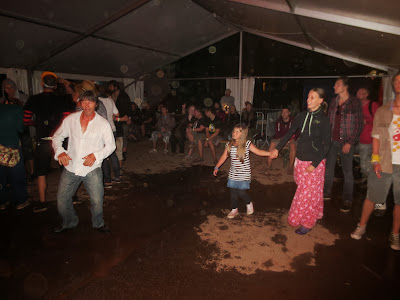











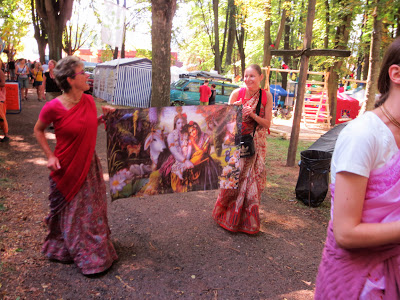





















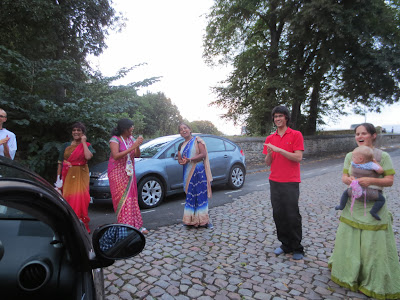






 179 photos: Janmasthami Iskcon Phoenix 2013
179 photos: Janmasthami Iskcon Phoenix 2013  82 photos: ISKCON Koh Samui (Thailand) Preaching
82 photos: ISKCON Koh Samui (Thailand) Preaching  95 photos: Preaching programs in New Orleans and New Talavan USA
95 photos: Preaching programs in New Orleans and New Talavan USA  Indradyumna Swami: Amongst the background of religious traditions existing for thousands of years in Israel devotees of Krsna blissfully propagate the chanting of God’s holy names. People love the kirtan and easily join in. Just another example that kirtan is a universal process that can benefit the entire world.
Indradyumna Swami: Amongst the background of religious traditions existing for thousands of years in Israel devotees of Krsna blissfully propagate the chanting of God’s holy names. People love the kirtan and easily join in. Just another example that kirtan is a universal process that can benefit the entire world.  17 photos: First day of Book Distribution @ Moscow International Book Fair 2013
17 photos: First day of Book Distribution @ Moscow International Book Fair 2013